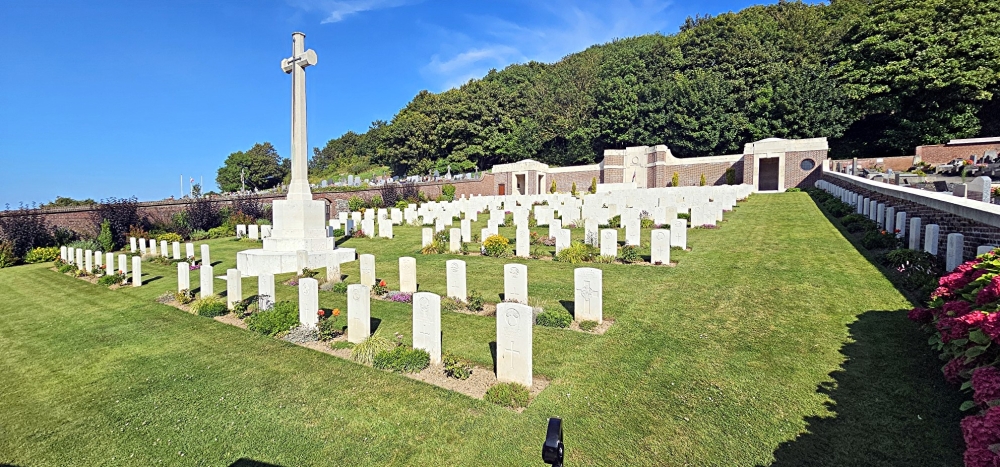Perrin, Desmond (Des) Palmer
- Date of birth:
- November 27th, 1918 (Wellington, New-Zealand )
- Date of death:
- September 10th, 1944 (Godelmesnil/Seine-Maritime, France)
- Buried on:
- Commonwealth War Cemetery Le Tréport
Plot: I. Row: P. Grave: 1. - Service number:
- 404404
- Nationality:
- New Zealander
Biography
Desmond Palmer Perrin was born on 27 November 1918 in Wellington, North Island, New Zealand. His father was Alfred Charles Robert (Bert) Perrin was 26 years old at the time. His mother was Margaret Therese Blewman, aged 22. He received his secondary education at Marsist Brothers High School in Invercargill. After school, he went to work as an administrative assistant.
Shortly after the outbreak of war, he enlisted in the Royal New Zealand Air Force in Wellington the following year, on 5 January 1940, and began his pilot training, which he successfully completed.
On 22 November 1941, Des Perrin was involved in an aircraft collision over the Isle of Wight. He was then flying in a Hawker Hurricane Mk.IIc of the RAF. No. 1 Squadron which was then based at RAF Tangmere. His fighter with serial number Z3899, fuselage code JX-W, collided with a Hawker Hurricane IIc with serial number BD940. Although injured, Des Perrin managed to jump out of the plane. The other pilot, 28-year-old Sergeant Leslie James Travis was killed in the crash. It was concluded as the cause that bad weather, after nightfall, had led to the accident.
On 9 November 1943, he was awarded the Distinguished Flying Cross (DFC) for his service record.
On 21 March 1944, at the age of 25, Des married Anna Margarette McBeth Cleland at St Francis Church in Glasgow Gorbals, Lanarkshire, Scotland. After more than six months of marriage, Des Perrin died. The couple had no children when Des Perrin was killed on Sunday 10 September 1944.
At about 19:10 that evening, F/L (captain) Des Perrin took off from forward RAF airbase (Advanced Landing Ground) B.35 Godelmesnil, located in the Seine Maritime department in northern France. He was taking off as a formation leader of four Hawker Typhoon's 1B, armed with missiles for an attack on a stronghold in/near Le Havre, when his Typhoon 1B, serial number MP116, fuselage code TP-T, suffered a blowout on the steel plates that formed the runway. In the process, the Typhoon overturned after which it exploded. He was buried in Le Treport military cemetery, Box I, grave P.1.
(Often under enemy fire, engineers began constructing so-called ALG (Advanced Landing Grounds). At a rapid pace, the ground was levelled over which so-called Square Mesh Track (SMT) was rolled out. The SMT developed by the British consisted of a heavy metal mesh (diamond shape of 8 x 8 cm) on large rolls. The first airfields in Normandy were laid out this way. Later ALGs were constructed with Prefabricated Hessian (Burlap) Surfacing (PHS or PBS). This consisted of, asphalt-impregnated burlap 100 metres in length with a width of about one metre. The PHS/PBS was used to prevent dust clouds created by aircraft propellers. It was not uncommon to roll out the SMT over the PHS, ‘the best of both worlds’)
Do you have more information about this person? Inform us!
- Period:
- Second World War (1939-1945)
- Rank:
- Flight Lieutenant
- Awarded on:
- October 20th, 1943
'This officer has participated in very many sorties and has led his flight with distinction on all occasions. In the course of his activities, Flight Lieutenant Perrin has executed destructive attacks on locomotives, rail installations and enemy shipping. On one occasion he obtained a hit on an ammunition truck which blew up with such violence that his aircraft was endangered by the explosion. In addition, Flight Lieutenant Perrin has destroyed a Messerschmitt 210. His fine fighting qualities have been highly commendable'. AWMM Online Cenotaph..
Sources
- Photo 1: Corin Gelderblom
- Photo 2: Corin Gelderblom
- - FLTLT Desmond Palmer “Des” Perrin (1918-1944) - Find a Grave-gedenkplek
- 10th September 1944 198 Squadron Typhoon IB MP116 Fl/Lt. Perrin DFC





